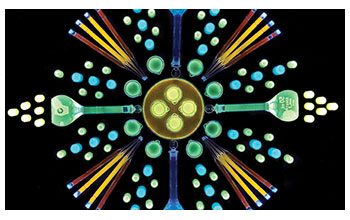Multimedia Gallery
Tubes filled with quantum dots
Tubes filled with quantum dots. Researchers at Lehigh University have found a better, more natural approach to the production of quantum dots.
More about this image
A team of researchers led by Bryan Berger, an associate professor of chemical and biomolecular engineering and bioengineering at Lehigh University, has successfully demonstrated the first precisely controlled, biological way to manufacture quantum dots (QDs). This one-step method starts with engineered bacterial cells in a simple, aqueous solution and ends with functional semiconducting nanoparticles, all without resorting to high temperatures and toxic chemicals.
The technique has great potential for green manufacturing of QDs, which are used in transistors, solar cells, LEDs, lasers and medical imaging. The manufacturing processes currently used to produce them are messy and require toxic solvents, heat and high pressure.
Several years ago, Berger experimented to see if the bacterial strain Stenotrophomonas maltophilia could be manipulated to generate QDs on command, since it had previously been known to exhibit heavy metal resistance. Teaming up with colleagues from Lehigh and elsewhere, Berger used a $2 million grant he received in 2013 from the National Science Foundation's Division of Emerging Frontiers in Research and Innovation (EFRI) to verify the production of cadmium sulfide QDs using an engineered form of Stenotrophomonas. The researchers tailored the bacteria to grow nanocrystalline metal sulfides including QDs, building on previous research.
Berger says using a biological approach cuts down on production needs, is less burdensome on the environmental and cuts production time quite a lot. Nanocrystals can take hours to grow using industrial processes; biosynthesis takes minutes to hours, maximum, depending on the QD size.
More recently, the researchers have branched into creating lead sulfide QDs and are working on oxide-based materials, widening the range of QD practical applications.
[Research supported in part by NSF grant EFMA 13-32349. Berger is a past recipient of an NSF Faculty Early Career Development (CAREER) award.]
To learn more about this research, see the Lehigh news story Quantum dots by nature. (Date image taken: 2016; date originally posted to NSF Multimedia Gallery: Jan. 9, 2018)
Credit: Photo by Christa Neu; Lehigh University Communications and Public Affairs
Images and other media in the National Science Foundation Multimedia Gallery are available for use in print and electronic material by NSF employees, members of the media, university staff, teachers and the general public. All media in the gallery are intended for personal, educational and nonprofit/non-commercial use only.
Images credited to the National Science Foundation, a federal agency, are in the public domain. The images were created by employees of the United States Government as part of their official duties or prepared by contractors as "works for hire" for NSF. You may freely use NSF-credited images and, at your discretion, credit NSF with a "Courtesy: National Science Foundation" notation.
Additional information about general usage can be found in Conditions.
Also Available:
Download the high-resolution JPG version of the image. (206.0 KB)
Use your mouse to right-click (Mac users may need to Ctrl-click) the link above and choose the option that will save the file or target to your computer.



